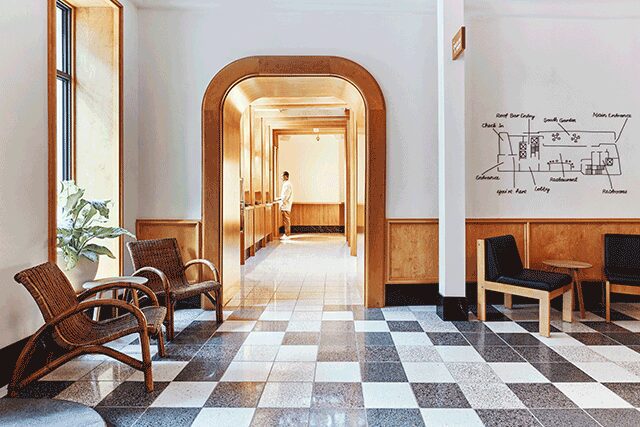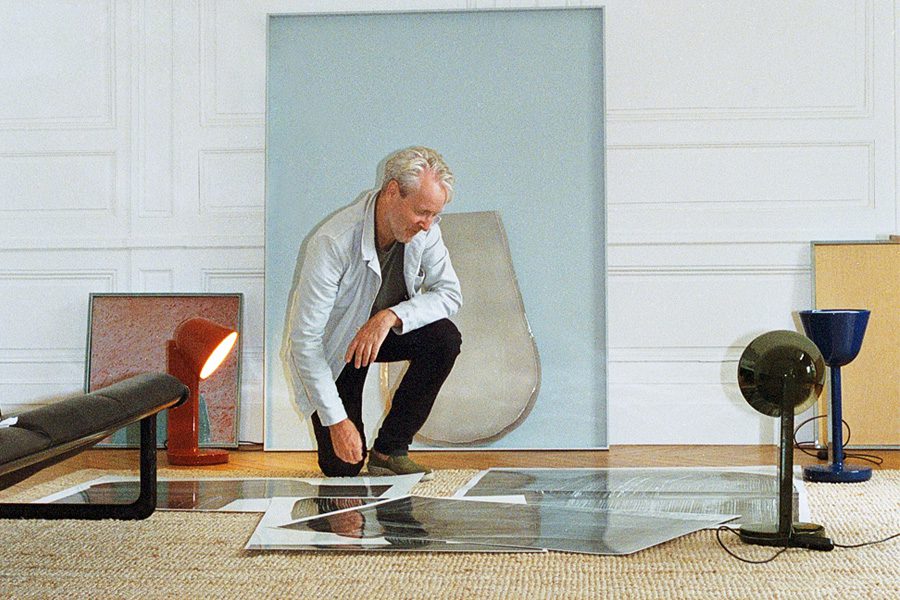Sister City, the Ace Hotel spinoff on New York’s Lower East Side, debuted earlier this year in a former Salvation Army building. In the same vein, the first Ace Hotel, which opened its doors in Seattle in 1999, also resides in a building rife with history, a one-time maritime workers’ hotel built in 1909. The similarity between each location sparks a meaningful connection for Brad Wilson, Ace Hotel Group’s president. “[It was an] opportunity to revisit our roots and the idea of what it means to be a modern but value-oriented brand,” he says.
Founded by Alex Calderwood, Wade Weigel, and Doug Herrick, Ace Hotel Group is a pioneer in the lifestyle movement and is often credited for shaping the modern-day hotel experience. Twenty years ago, defining a hotel’s culture by animated public spaces that doubled as communal hubs for the neighborhood and forging collaborations with local artists and makers that fostered a dialogue between the hotel and the city were looked at as quirky, unconventional approaches. Now, Sister City honors that same point of view but in a more stripped-down way. The brand also serves as an opportunity for Wilson to find balance between the maturing Ace customer and a new generation of travelers. “We can be different; we don’t have to copy ourselves,” he explains. “We have always focused on the details, and that comes through in everything we do, whether it’s a value project on the Lower East Side in New York or a luxury hotel in New Orleans. Our hotels feel like somebody cared about this and thought it out.”
Given the popularity of the Roman and Williams-designed Ace Hotel New York, one of nine Ace properties that also includes Seattle, Chicago, Los Angeles, New Orleans, Palm Springs, Pittsburgh, and Portland, Oregon, as well as a London venture crafted by Universal Design Studio, it’s natural that Sister City would first land in downtown New York.
The prototype for a cozy, pared-down microhotel conceived, designed, and branded by Ace’s multidisciplinary in-house 55-person creative group Atelier Ace, Sister City is a 200-room retreat on the gritty Bowery. Guests enter through an almost hidden entry gate, immediately transporting them out of the bustling city streets and into a soothing, front-facing garden. (There’s a second entrance on Freeman Alley.) Alternatively, a rooftop bar and terrace on the 11th floor provides sweeping sunset views against the backdrop of lower Manhattan. “We loved this juxtaposition between the urban compression and volume and the sanctuary within,” explains Wilson.
Modernism without minimalism is the ethos of Sister City, keeping the aesthetic “organic, warm, and human,” Wilson says. In the all-day, onsite restaurant Floret, for instance, a marble bar that mimics the casualness of an Italian espresso café is paired with vintage seating reminiscent of Finnish architect and designer Alvar Aalto’s work.
Petite guestrooms are smartly appointed and inspired by the precision of a bento box. “Everything is in its place and has its purpose, but we also looked at how to expand outside of that,” he says about the organization of the rooms. To minimize clutter, irons and ironing boards are found in corridor closets, vanities are separated from toilets, and some of the furnishings are convertible, like fold-down desks. With Sister City, there is a chance to present something new yet equally as desired to the traditional Ace customer. “You still feel there’s somebody behind it, that somebody made it. Some of those important elements that we think need to be in a hotel are there,” Wilson says.
Unlike this friendly, low-key brand, ripe for new builds in urban locations, Maison de la Luz in New Orleans, another recent Ace Atelier-born concept, expands on Ace Hotel’s sophisticated layers. Next door to the Ace Hotel New Orleans, this one-time city hall annex at Lafayette Square reveals great bones that feature original marble, metalwork, and dramatic grand staircases. “It shouldn’t be about excess,” Wilson says of the new 67-room property, “but something rare and special.” Designed in partnership with Los Angeles-based Studio Shamshiri as a luxury guesthouse, each space is built around a complete sense of privacy. To bolster that exclusive, hushed atmosphere, there is a private salon solely for guests that transitions through a revolving bookcase into the open-to-the-public law library-turned-Bar Marilou, from Paris-based group Quixotic Projects.
Each of the two new brands are reminders of Ace Hotel Group’s devotion to “the craft, the hand, the people who make hotels,” explains Wilson. “We’ve never been like the big guys who go, ‘We’re going to announce 15 buildings next year.’ It’s just not our style.”
As Wilson reflects on the past two decades, he says he still sees Ace as “the young, scrappy” hotel company trying to find a foothold in the industry. But now, as they have reached adulthood, Ace is forging a new path. Though often imitated, he says his team “rarely copies what we did last time. We’ve always been in a process of evolution and bringing in other brands to re-energize us.”
What does align with their plans is a second international property. Ace Hotel Kyoto will open in 2020 as a nod to Wilson’s past developing Nikko Hotels for Japan Airlines; the time Ace Hotel Group vice president Ryan Bukstein spent studying in Japan; and Calderwood’s early entrepreneurial stint selling secondhand, U.S.-made denim in Tokyo. Housed in a building designed by Kengo Kuma, it will incorporate a red-brick structure originally built in 1926 that once housed a telephone exchange.
Immediately after Calderwood’s sudden death in 2013, Wilson received a phone call from Ian Schrager, who offered, along with his condolences, a bit of advice: “He said: ‘You always have to evolve. You want to do the things like Alex would want them done, but you have to change. You have to think about what Alex would do today,’” Wilson recalls. “We have changed. What you see with Sister City or Maison isn’t necessarily something that was in Alex’s mind at the time the company was founded, but it’s definitely all out of the same root, the same process, and they’re all [things] we know he would be proud of.”

A door in a library wall of Bar Marilou leads to the private salon in Maison de la Luz, with golden velvet sofas and tassel-trimmed ottomans



